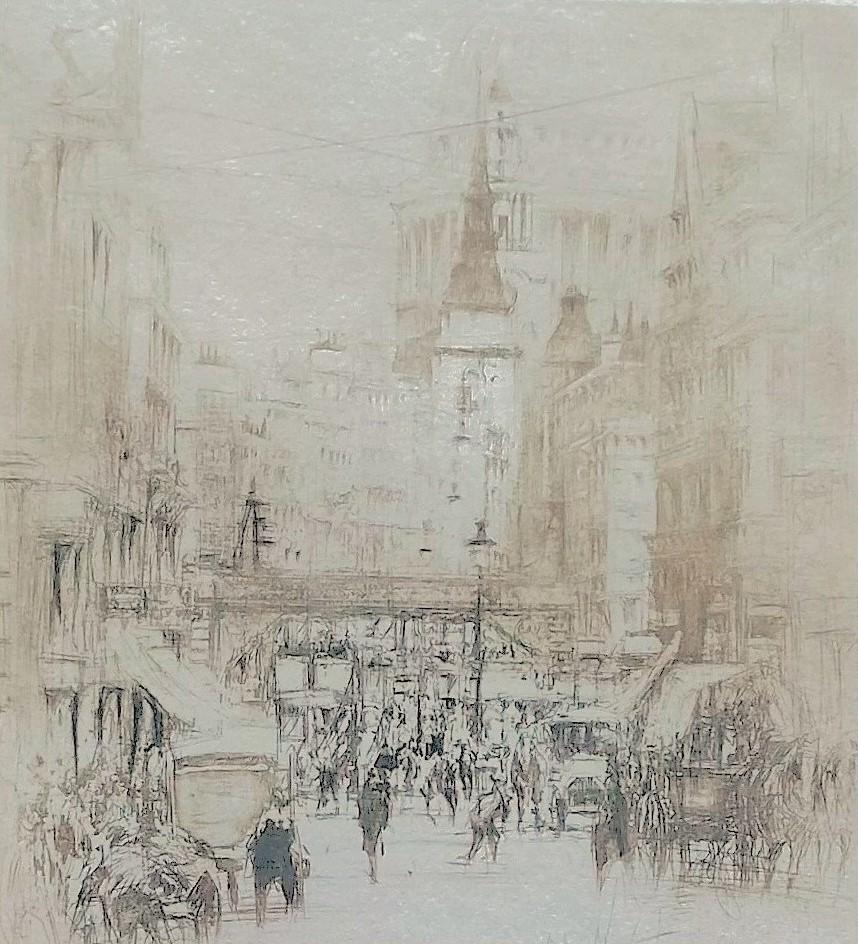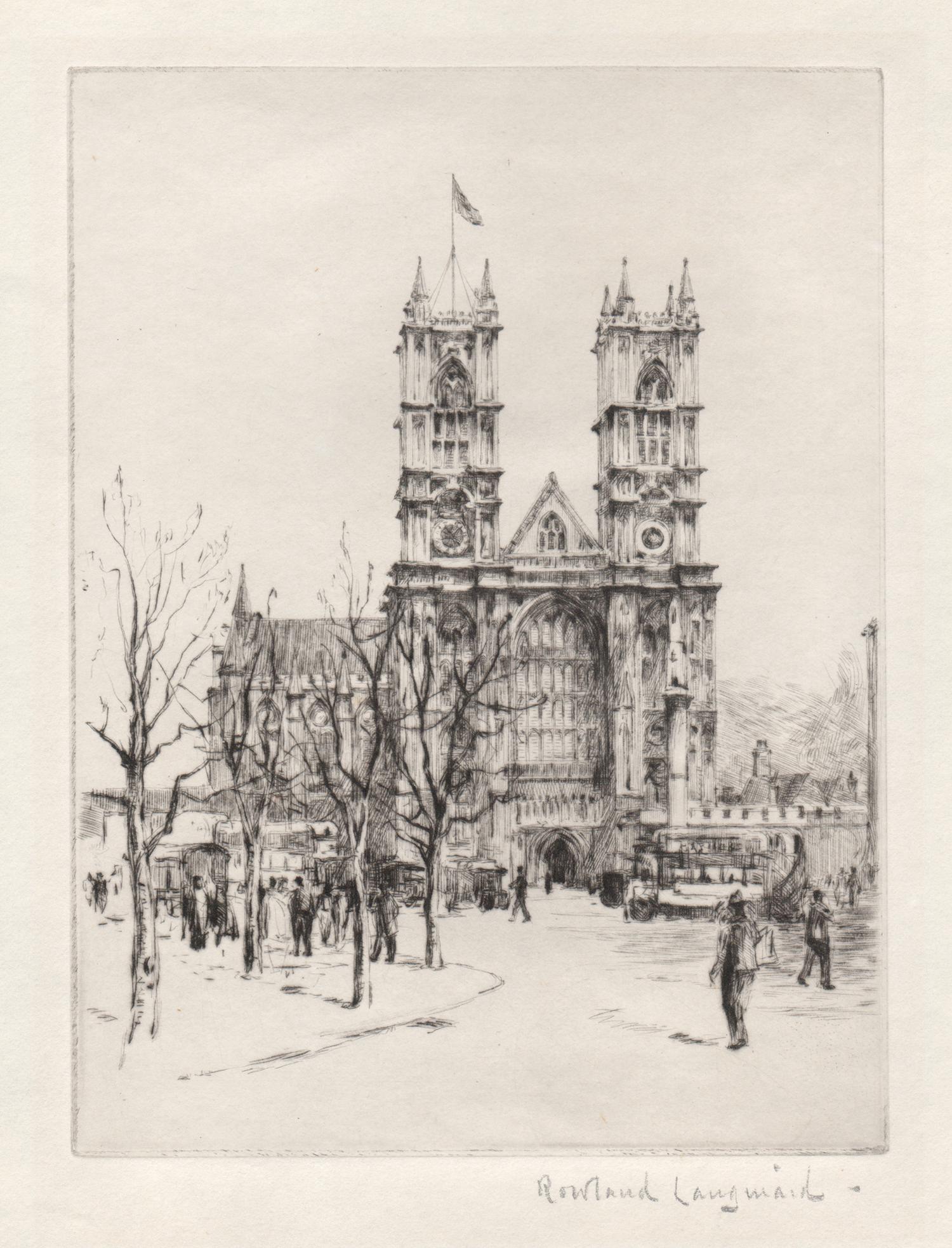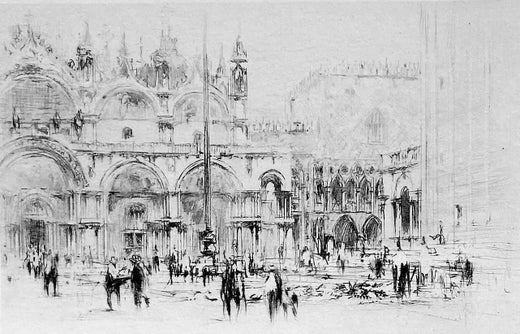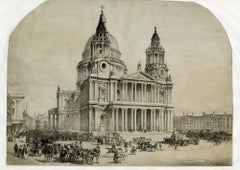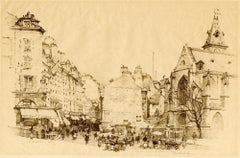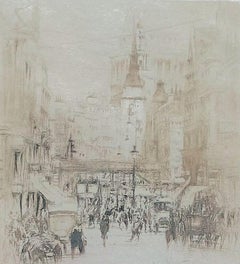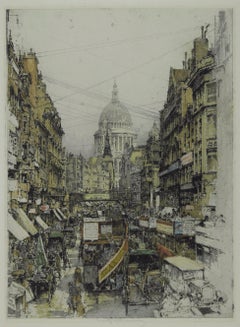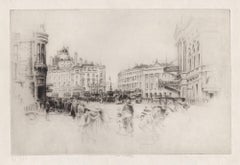Items Similar to Ludgate Hill
Want more images or videos?
Request additional images or videos from the seller
1 of 4
William Walcot R. E. Hon. R. I. B. A.Ludgate Hill1921
1921
$400
£302.63
€349.28
CA$558.69
A$621.16
CHF 325.14
MX$7,618.26
NOK 4,139.82
SEK 3,908.48
DKK 2,606.43
Shipping
Retrieving quote...The 1stDibs Promise:
Authenticity Guarantee,
Money-Back Guarantee,
24-Hour Cancellation
About the Item
Etching with drypoint and aquatint on light cream wove paper, 5 1/2 x 5 inches (140 x 122 mm), full margins. Signed in pencil in the lower margin. One of a total of 400 signed impressions; 275 designated for distribution in the United Kingdom, and 125 for the United States. In good condition with some minor mat tone, and two dots of adhesive residue in the top and right and left margins, well outside of the image area.
- Creator:William Walcot R. E. Hon. R. I. B. A. (1874 - 1943, British)
- Creation Year:1921
- Dimensions:Height: 5.5 in (13.97 cm)Width: 5 in (12.7 cm)
- Medium:
- Movement & Style:
- Period:
- Condition:
- Gallery Location:Middletown, NY
- Reference Number:Seller: BH13881stDibs: LU1979213157892
William Walcot R. E. Hon. R. I. B. A.
When he was seventeen, William Walcot began to study architecture under Louis Benois at the Imperial Academy of Art in Saint Petersburg. He went to Paris where he continued his studies at the Ecole des Beaux-Arts and the Atelier Redon. He practiced as an architect briefly in Moscow, designing the Hotel Metropole in 1898. In 1907, Walcot settled in London where he was employed as a draughtsman by the South-African-born architect, Eustace Frere. In 1933, Walcot designed one London building, 61 St. James Street, but his main architectural activity was that of a freelance draughtsman. He produced drawings and etchings for architects to show their clients and to exhibit at the Royal Academy summer exhibitions. Throughout the 1920s and 1930s, Walcot was the most celebrated architectural draughtsman in England, enhancing the scale and drama of the buildings he depicted with his mastery of techniques including watercolor and gouache.
About the Seller
5.0
Gold Seller
Premium sellers maintaining a 4.3+ rating and 24-hour response times
Established in 2004
1stDibs seller since 2022
69 sales on 1stDibs
Typical response time: 3 hours
- ShippingRetrieving quote...Shipping from: Middletown, NY
- Return Policy
Authenticity Guarantee
In the unlikely event there’s an issue with an item’s authenticity, contact us within 1 year for a full refund. DetailsMoney-Back Guarantee
If your item is not as described, is damaged in transit, or does not arrive, contact us within 7 days for a full refund. Details24-Hour Cancellation
You have a 24-hour grace period in which to reconsider your purchase, with no questions asked.Vetted Professional Sellers
Our world-class sellers must adhere to strict standards for service and quality, maintaining the integrity of our listings.Price-Match Guarantee
If you find that a seller listed the same item for a lower price elsewhere, we’ll match it.Trusted Global Delivery
Our best-in-class carrier network provides specialized shipping options worldwide, including custom delivery.More From This Seller
View AllSt. Paul's From Ludgate Hill, from Original Views of London As It Is
By Thomas Shotter Boys
Located in Middletown, NY
Lithograph with hand tinting on heavy wove paper, full margins. Significant condition issues in the margins which include adhesive residue, edge tears and minor edge losses. The image area is clean with minor mat tone, however, colors are slightly attenuated. The verso shows moderate uneven toning. Issues primarily exist outside of the image area. This large and lively work was printed by Charles Hullmandel.
_______
The images in Boys's 1842 portfolio, Original Views of London...
Category
Mid-19th Century English School Landscape Prints
Materials
Handmade Paper, Watercolor, Lithograph
Victoria Station (London)
By Kenneth Holmes, A.R.C.A.
Located in Middletown, NY
A lovely dark and inky impression, signed by the artist.
Drypoint etching on cream laid paper, 10 7/8 x 8 5/8 inches (275 x 218 mm), full margins. Signed in pencil, lower center marg...
Category
Early 20th Century Modern Landscape Prints
Materials
Laid Paper, Drypoint, Etching
North View of St. Paul's Cathedral, London / English School
Located in Middletown, NY
London: Tallis & Co., 1851.
Lithograph on cream wove paper, 11 3/4 x 15 3/4 inches (297 x 398 mm), with vaulted margins at the top sheet edge. Significant toning, and some edge wear...
Category
Mid-19th Century English School Landscape Prints
Materials
Lithograph, Handmade Paper
Rue Moufftard, Paris
By Samuel Chamberlain
Located in Middletown, NY
Lithograph in brown ink on lightweight, cream laid Japon paper with a deckle edge, 10 3/4 x 17 inches (274 x 432 mm), full margins. Signed and numbered 9/35 in pencil in the lower ma...
Category
Early 20th Century Realist Landscape Prints
Materials
Handmade Paper, Lithograph
North View of St. Paul's Cathedral, London English School, 19th century
Located in Middletown, NY
London: Tallis & Co., 1851
Lithograph on cream wove paper, 11 3/4 x 15 3/4 inches (297 x 398 mm), with vaulted margins at the top sheet edge. Significant toning, and some edge wear. ...
Category
Mid-19th Century English School Interior Prints
Materials
Handmade Paper, Lithograph
The South East Prospect of Westminster Bridge
By Alfred Benjamin Cole
Located in Middletown, NY
After Giovanni Antonio Canal, called Canaletto
Copper plate engraving with hand coloring on cream laid paper with the Arms of France watermark (a crown in shield topped by a fleur-de-lys and the letters GR), 22 3/4 x 15 3/4 inches (576 x 400 mm), wide to full margins. Multiple vertical and horizontal creases from folding and rolling; none appear to be particularly hard, there is however some associated cockeling. While there is some minor mat tone visible around the perimeter of the sheet, the extensive handcoloring remains extremely fresh and saturated in the intended areas. There are edge tears at each the right and left sheet edge (outside of the image area) due to an improper effort to mount the sheet to a mat. Otherwise in very good condition with all issues being consistent with age.
The print is wrongly titled "The South East Prospect of Westminster Bridge...
Category
Mid-18th Century English School Landscape Prints
Materials
Laid Paper, Engraving, Watercolor
You May Also Like
Ludgate Hill
By William Walcot R. E. Hon. R. I. B. A.
Located in Storrs, CT
Ludgate Hill. 1921. Etching, aquatint, and drypoint. Dickins 69. 5 5/8 x 5 1/8 (sheet 13 5/8 x 9 3/4). A fine proof with plate tone, printed on 'J Wha[tman] cream wove paper. Edition of 275 for the UK and 125 for the US. Signed in pencil.
Ludgate Hill is a street that runs west from St. Paul's Churchyard to Ludgate Circus (built in 1864), and from there becomes Fleet Street. The Ludgate Hill railway station, between Water Lane and New Bridge Street, is a station of the London, Chatham, and Dover Railway. It was closed before World War II and the railway bridge and viaduct between Holborn Viaduct and Blackfriars stations was demolished in 1990 to enable the construction of the City Thameslink railway station in a tunnel. This also involved the regrading of the slope of Ludgate Hill at the junction. About halfway up Ludgate Hill is St Martin, Ludgate church. This was physically joined to the Ludgate.
When he was seventeen, William Walcot began to study architecture under Louis Benois at the Imperial Academy of Art in Saint Petersburg. He went to Paris where he continued his studies at the Ecole des Beaux-Arts and the Atelier Redon. He practiced as an architect briefly in Moscow, designing the Hotel...
Category
Early 20th Century Modern Landscape Prints
Materials
Drypoint, Etching, Aquatint
$400 Sale Price
20% Off
Fleet Street, London
By Luigi Kasimir
Located in Fairlawn, OH
Fleet Street, London
Soft ground etching & aquatint, c. 1936
Signed in pencil by the artist (see photo)
Condition: Very good condition with brown paper tape along the edges of the la...
Category
1930s Landscape Prints
Materials
Etching, Woodcut
Piccadilly Circus, London, etching by Frederick Farrell, circa 1920
Located in Melbourne, Victoria
Signed in pencil below the image by the artist. Blind stamps of etching societies lower left just under the image.
Frederick Farrell was a Scottish etcher specializing in architectu...
Category
1920s Other Art Style Landscape Prints
Materials
Drypoint, Etching
Westminster Abbey, London. Rowland Langmaid signed artist etching print
By Rowland Langmaid
Located in Melbourne, Victoria
Westminster Abbey.
Signed in pencil by the artist below the image.
Rowland Langmaid was a marine painter and etcher who studied under William Lione...
Category
1930s English School Landscape Prints
Materials
Etching
Charing Cross - The Statue of Charles I.
By William Walcot R. E. Hon. R. I. B. A.
Located in Storrs, CT
Charing Cross -- The Statue of Charles I. 1919. Etching with aquatint and drypoint. 3 5/8 x 4 7/8 (sheet 9 1/8 x 11 3/8). A fine proof with tonal wiping, printed on cream-wove paper. Signed in pencil.
Charing Cross is located at the junction of the Strand, Whitehall, and Cockspur Street in Central London, England. The name originates from the Eleanor cross installed by King Edward I as a memorial to his wife, Eleanor of Castile at the former hamlet of Charing. Since 1675, the cross site has been occupied by a statue of King Charles I mounted on a horse. The pedestal is thought to be designed by Wren and carved by Grinling Gibbons.
Chelsea Old Church, also known as All Saints, is an Anglican church, on Old Church Street, Chelsea, London SW3, England, near Albert Bridge. It is the church for a parish in the Diocese of London, part of the Church of England. Inside the Grade I listed building, there is seating for 400 people. There is a memorial plaque to the author Henry James (1843–1916) who lived nearby on Cheyne Walk. To the west of the church is a small public garden containing a sculpture by Sir Jacob Epstein.
When he was seventeen,William Walcot began to study architecture under Louis Benois at the Imperial Academy of Art in Saint Petersburg. He went to Paris where he continued his studies at the Ecole des Beaux-Arts and the Atelier Redon. He practiced as an architect briefly in Moscow, designing the Hotel...
Category
Early 20th Century Modern Landscape Prints
Materials
Drypoint, Etching, Aquatint
$780 Sale Price
20% Off
Fleet Street, London
By Luigi Kasimir
Located in San Francisco, CA
This artwork titled "Fleet Street, London" c.1925 is a color etching by Austrian artist Luigi Kasimir 1881-1962. It is hand signed in pencil by the artist estate at the lower center. The plate mark (image) size is 20.5 x 15 inches, framed size is 34 x 28 inches. Custom framed in the wooden original brown and gold distressed style frame, with light beige fabric matting and gold color fillet. It is in excellent condition, the frame have very small minor restorations, practically invisible.
About the artist.
Luigi Kasimir was born in 1881 at Pettau, today Ptuj, Slovenia, then a part of the Austro-Hungarian monarchy. He inherited his talent from his ancestors; his grandfather was a painter and a poet, and his father an officer in the Habsburg army, who later became a professional painter. Kasimir attended the Vienna Academy of Art where he studied under Wilhelm Unger, who introduced him to the technique of the coloured etching, and also to his future wife, the artist Tanna Hoernes...
Category
Early 20th Century Realist Figurative Prints
Materials
Etching
More Ways To Browse
Jonathan Green Signed Print
Peter Max Flower Lady
Alex Katz Yellow Flags
Christo Running Fence
Francois Houtin Hermes
Hassam Etching
Hiroshige Bridge
Peter Max Sage
Colorado Ski Poster
Kerr Eby
Lebanon Vintage Poster
M Howell Painting
Vintage Lebanese Posters
William Stafford
Bob Cato
Cardboard Banksy
Currier Ives View Of New York
David Roberts Lebanon
